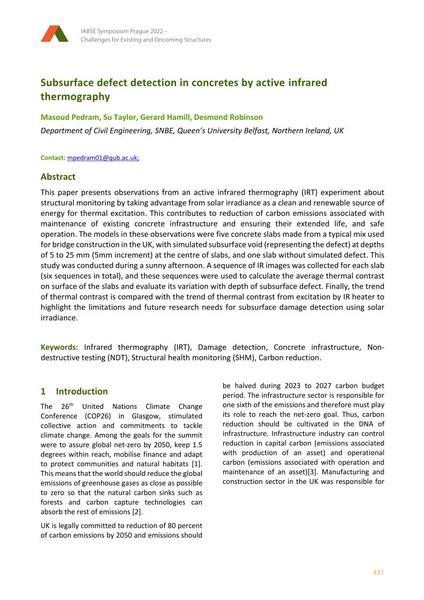Subsurface defect detection in concretes by active infrared thermography

|
|
|||||||||||
Bibliographic Details
| Author(s): |
Masoud Pedram
(Department of Civil Engineering, SNBE, Queen’s University Belfast, Northern Ireland, UK)
Su Taylor (Department of Civil Engineering, SNBE, Queen’s University Belfast, Northern Ireland, UK) Gerard Hamill (Department of Civil Engineering, SNBE, Queen’s University Belfast, Northern Ireland, UK) Desmond Robinson (Department of Civil Engineering, SNBE, Queen’s University Belfast, Northern Ireland, UK) |
||||
|---|---|---|---|---|---|
| Medium: | conference paper | ||||
| Language(s): | English | ||||
| Conference: | IABSE Symposium: Challenges for Existing and Oncoming Structures, Prague, Czech Republic, 25-27 May 2022 | ||||
| Published in: | IABSE Symposium Prague 2022 | ||||
|
|||||
| Page(s): | 431-436 | ||||
| Total no. of pages: | 6 | ||||
| DOI: | 10.2749/prague.2022.0431 | ||||
| Abstract: |
This paper presents observations from an active infrared thermography (IRT) experiment about structural monitoring by taking advantage from solar irradiance as a clean and renewable source of energy for thermal excitation. This contributes to reduction of carbon emissions associated with maintenance of existing concrete infrastructure and ensuring their extended life, and safe operation. The models in these observations were five concrete slabs made from a typical mix used for bridge construction in the UK, with simulated subsurface void (representing the defect) at depths of 5 to 25 mm (5mm increment) at the centre of slabs, and one slab without simulated defect. This study was conducted during a sunny afternoon. A sequence of IR images was collected for each slab (six sequences in total), and these sequences were used to calculate the average thermal contrast on surface of the slabs and evaluate its variation with depth of subsurface defect. Finally, the trend of thermal contrast is compared with the trend of thermal contrast from excitation by IR heater to highlight the limitations and future research needs for subsurface damage detection using solar irradiance. |
||||
| Keywords: |
damage detection structural health monitoring (SHM) Carbon Reduction Infrared thermography (IRT) Concrete infrastructure Non- destructive testing (NDT)
|
||||
| Copyright: | © 2022 International Association for Bridge and Structural Engineering (IABSE) | ||||
| License: | This creative work is copyrighted material and may not be used without explicit approval by the author and/or copyright owner. |
||||
